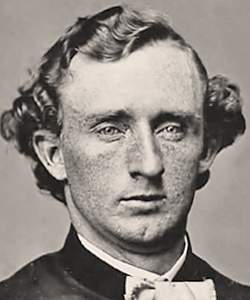George Armstrong Custer, Civil War (American National Biography)
Scholarship
Custer found his calling in the Civil War. Two years of staff duty, including a tour as aide to General George B. McClellan (1826-1885), established his military skill, both as a staff officer and in combat. So impressed was General Alfred Pleasonton, commander of the Cavalry Corps of the Army of the Potomac, that he recommended Custer for promotion. In June 1863 Captain Custer was appointed brigadier general of volunteers and given command of the Michigan Cavalry Brigade. At twenty-three, he was the youngest general in the Union army. Almost instantly General Custer made a dazzling name for himself. On the third day of Gettysburg the Michigan Brigade played a key role in turning back General J. E. B. Stuart's Confederate cavalry, which threatened the Union rear at the very moment of George Edward Pickett's charge on the Union center. Thereafter Custer's successes accumulated one after another. He became known throughout the army for smashing cavalry charges, for heedless bravery, for tactical brilliance more instinctive than cerebral, for heavy casualties, and, with long yellow hair and gold-bedecked black uniform, for personal flamboyance. Newspapers made him a household name.
Robert M. Utley, "Custer, George Armstrong," American National Biography Online, February 2000, http://www.anb.org/articles/04/04-00290.html.
George Armstrong Custer, Custer's Last Stand (American National Biography)
Scholarship
By 1875 Custer was widely admired as the nation's foremost Indian fighter. He boasted a solid record, but the fame came as much from newspaper attention and from his own writings. He published a series of magazine articles and then consolidated them into an autobiography, which reached a large audience. Custer's final campaign, ending in the battle of the Little Bighorn on 25 June 1876, earned him immortality and a place in the national folklore. The disaster, low point for the army in the Great Sioux War of 1876, occurred when the Seventh Cavalry attacked a large Sioux and Cheyenne encampment on Montana's Little Bighorn River. Five companies under Custer's immediate command, more than two hundred officers and troopers, were wiped out by nearly two thousand warriors defending their families. The remaining seven companies of the regiment, under Major Marcus A. Reno and Captain Frederick W. Benteen, successfully defended an entrenched hilltop for two days until reinforcements arrived.
At once the subject of bitter controversy, "Custer's Last Stand" has been vigorously debated ever since. Custer has been charged with recklessness, Reno with cowardice, and their superiors with faulty strategy. Defenders ensure that the arguments will endure forever, as will the image of the doomed but heroic figure of Custer facing death on a hilltop. In large part, however, the soldiers lost because the Indians won--although in victory lay the seeds of their ultimate defeat.
At once the subject of bitter controversy, "Custer's Last Stand" has been vigorously debated ever since. Custer has been charged with recklessness, Reno with cowardice, and their superiors with faulty strategy. Defenders ensure that the arguments will endure forever, as will the image of the doomed but heroic figure of Custer facing death on a hilltop. In large part, however, the soldiers lost because the Indians won--although in victory lay the seeds of their ultimate defeat.
Robert M. Utley, "Custer, George Armstrong," American National Biography Online, February 2000, http://www.anb.org/articles/04/04-00290.html.











